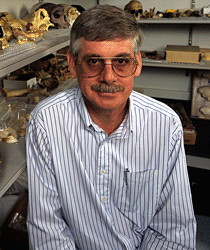
Posted on 10/20/2006 10:22:23 AM PDT by blam
Bending the Branches
October 18, 2006
A new study of human fossils asks, what if we are the odd ones?

(Washington University, St. Louis)
Most people think of humans as the top, the apex of the family tree. But new research suggests this quintessentially human infatuation with ourselves may have impaired our judgment. Erik Trinkaus, a paleontologist and Neandertal expert at Washington University in St. Louis, believes that modern human features are unusual enough, compared with ancestral members of the genus Homo, to make us a side branch of the family tree. Neanderthals have generally been seen as evolutionary outcasts, but through comparisons and analyses of unique and shared traits, published in the August issue of Current Anthropology, Trinkaus concludes that modern humans are morphologically more divergent from ancestral humans than Neanderthals. This leads to the question, then: Why are modern humans so different? ARCHAEOLOGY spoke with Trinkaus about his research and its implications concerning the ongoing story of human evolution.
How long have you been studying Neanderthals, and when did this theory first occur to you?
I've been working on Neanderthals since the early 70s, when I was a graduate student. [The theory] actually occurred to me then, so that's been, hate to say it, over 30 years ago. The features that are considered distinctive of Neanderthals show up very early in the genus Homo, and I started wondering to what extent Neanderthals were special and to what extent they were just simply a late-evolved version of what I've come to call archaic Homo. I can tell you a little anecdote.
Sure.
When I was a graduate student I started out my research in museums in France, Belgium, Germany, and then I went on to England to work on material in London. And while I was there a senior British paleontologist-anatomist gave a talk on recently discovered human fossils from East Africa. This was the time when a number of important members of the genus Homo and Australopithecus were coming out of East Africa. One of the things he showed were some human, early genus Homo thigh bones, or femora, that were very complete; the first really complete ones that we had. So he showed these and I said to myself, "I've seen those somewhere before." I went up to him afterward and said, "That's a nice looking Neanderthal femur you have there." And he kind of looked at me like, "Sonny, when you grow up and learn some paleontology you'll do just fine," when in fact he was wrong.
In fact, 10 years later, I published a note on this. A lot of the limb morphology, a lot of the limb shape we see in Neanderthals first shows up 2 million years ago, and basically continues up through Neanderthals and what we see in modern humans in terms of the shape. Not in terms of how they could walk or anything like that, but what we've seen, in terms of shape, is in fact different from what had gone on.
So the whole idea started early, and it's been in the back of my mind, and gradually, over the years, as I've worked on, not just Neanderthals, but earlier human fossils. I've worked increasingly, in the last decade or so, on anatomically modern humans, and it just struck me that we really need to sort out which aspects are special to modern humans, and which aspects are special to the Neanderthals.
Why hadn't people looked at this before?
What came out of this is a perception of the field that goes back to the early part of the twentieth century, when the only prehistoric non-humans we knew were Neanderthals. And of course, we were assumed to be normal, as expected, and Neanderthals were different Therefore, the Neanderthals were strange, unusual, deviant. I use those words, partially because of their pejorative sense, because Neanderthals were considered somehow deviant, somehow not quite what they should be. A variety of terms were used to describe aspects of the Neanderthals in the early part of the century, the most common one was "specialized." Well people in the early twentieth century didn't imply or state any specific function, they just implied that it was different. When we talk about "specialized," today we imply specialized for some specific task; when we talk about specialized we think of it in an adaptive sense. And in the last 20 or 30 years, what they used to call specialized, has become codified in evolutionary biology as "derived." It's different from the ancestral pattern, a derived characteristic, something that has changed significantly to a different character state form from the ancestral pattern.
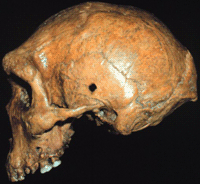
Broken Hill 1, an earlier archaic Homo from Zambia, dates to around 300,000 B.C. (© Natural History Museum, London)
And the Neanderthals?
So people have been talking about Neanderthals as being "derived" for a very long time, and people continue to do this. If you look at the literature in human paleontology over the last five years, there are numerous articles that are trying to explain why Neanderthals are different. They're trying to analyze features of the Neanderthals that appear different or weird, in some cases to understand them biologically, in some cases simply to document that they're different. There is virtually nothing in that same literature that tries to document why it is that modern humans are different from the previous 2 million years of human evolution. In other words, the question people are asking is not, "Why did modern humans evolve the anatomy we have?" What people are asking is, "Why do we have this weird group of humans who lived in Europe and the Near East that we call Neanderthals?" It's sort of like explaining why dinosaurs came about; they're the dinosaurs of human evolution, and people are trying to explain them.
Your new research takes a different approach.
The details of that paper come out of accumulated knowledge and research over the last 30 years, but the motivation for it, in part, is to say, "We're asking the wrong question." We shouldn't be asking why are Neanderthals Neanderthals. We can do that and that's legitimate and there are things about Neanderthals that are unique and I enumerate a number of them, hopefully all of them. There are a number of things about Neandertals that are what we call "shared derived" with modern humans, for example brain size, and as far as we know, brain complexity. In other words, both of them have similar changes relative to their earlier ancestral groups. But what I'm trying to say is, let's be more balanced.
And no matter how you count the traits--and every paleontologist would do this differently--modern humans are in fact more derived, cumulatively, than the Neanderthals, relative to the ancestral pattern. So when we figure out that, we realize this could lead to a type of special creation. Modern humans are special, very very different from everything else, and that's not my meaning. My meaning is simply that what is unusual, what we really need to explain in an evolutionary sense, is modern humans.
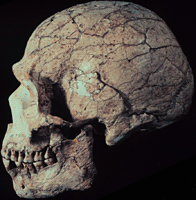
Skhul 5, a Middle Paleolithic early modern human from Israel, dates to around 90,000 B.C. (© Harvard Peabody Museum, Harvard University)
Should researchers stop focusing on Neanderthals?
We should look at Neanderthals! Neanderthals are a fascinating group, very interesting. There are many aspects of their biology that tell us a lot. I've long suspected that Neanderthals are generally representative of late archaic humans; that is, archaic humans of that general time period, and we just happen to know lots about Neanderthals and little about similar populations in Africa and Asia. Yes, we should continue to look at Neanderthals, but we should also be looking, equally or more, at early modern humans. The whole purpose [of the article] was to get some balance into all of this. Whereas if you look at what people do--and you see this in the professional literature and you see this in the media--the balance is very much toward documenting and sometimes trying to explain why Neanderthals are weird. I hate to say it, but I think we're the weirdoes.
There are plenty of Neanderthal and modern human samples, but how did you decide which fossil specimens to use as the morphologically ancestral examples?
I used everything I could get data on. I set out criteria in terms of time and space and members of the genus Homo, and for certain parts of the anatomy we have lots of fossils, or a reasonable amount of fossils. For other parts we have very few fossils. So I basically used everything I could get my hands on.
Do you think the diversity of these ancestral specimens is a strength or weakness of your analysis?
Traits or aspects that are highly variable in this generalized ancestral sample were simply excluded. There are a number of features where we have a pattern that seems to be distinctive of Neanderthals and another pattern that seems to be distinctive of modern humans, but we either don't know what the ancestral pattern is because we don't have the fossils, or the ancestral pattern is variable; just as variable as Neanderthals and modern humans pooled together.
There are a number of characteristics along those lines that I excluded from consideration. They're not included in my analysis because I couldn't make a decision about them. In the future, when we presumably will have more fossils, maybe I'll say some stuff about it. For example, there's increasing information that facial growth patterns of Neanderthals and early modern humans differ in some ways. We don't know what the ancestral pattern of facial growth was in, say, Homo erectus. We simply don't have the fossils. We have one early adolescent Homo erectus, whereas we have a whole growth series for Neanderthals and, of course, a whole growth series for modern humans. So that's just one example, but there are a number of different features of the hand skeleton and foot skeleton where we just simply don't know what the ancestral pattern is.
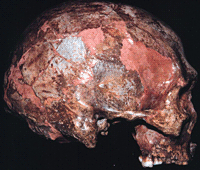
Dolni Vestonice 16, an Upper Paleolithic modern human from the Czech Republic, dates to 28,000-24,000 B.C. (© Czech Academy of Sciences, Brno)
How did you decide which 75 variables to compare?
I put together everything I could think of that was "derived" in one or two groups relative to the ancestral pattern. I made a complete list of them and over a considerable period of time I would look at this specimen vs. that specimen and this feature vs. that feature. There's a whole bunch of features I originally included that I subsequently deleted because I didn't have confidence that I could make a decision about them. There are features that I added in, there are some that I combined analysis for, and some that I split apart on assumptions of whether they were independent. As I worked though it, which was over a considerable period of time, the list evolved.
How would you summarize your results?
Very simply, it's that human evolution is a dynamic process and we have regional variants of humans forming, including both Neanderthals and modern humans, and both of them are "derived" relative to the ancestral pattern, modern humans more so. And if we're going to understand both of these groups and their evolutionary history we have to have a balanced approach for looking at the biology of both.
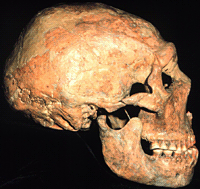
Shanidar 1, a Neanderthal, from Iraq, dates to around 60,000 B.C. (© Erik Trinkau)
What questions will this newer model lead to?
There are a whole series of features in modern humans that we know became the dominant pattern. The Neanderthals did disappear. There are no Neanderthals here today (although there may be traces of their ancestry, but that's a whole other issue). But there are a whole series of questions that really get back to the biology; that really get back to why do we get changes in certain kinds of patterns.
Some of them are probably purely random, you just happen to get someone with genetic variation and one [gene] versus the other really doesn't make a whole lot of difference. There are other features that we know are closely related to aspects of physiology. There are major changes in the inner ear and in the nose that we know are related to aspects of respiratory physiology. There are aspects of the pelvis that we know are related to reproduction. There are a number of these kinds of features and we don't really have very good models for why they come about. There are some people working on them, we have some ideas. I've expressed a number of ideas on why we get these changes in patterns, some of them have held up with time and some of them haven't. But [this analysis] is not really an exercise in coming up with answers, but rather focusing questions on those kinds of issues.
What has been the response to this research?
The response from the profession has been a few people who strongly agree and want to discuss details, and that's most of the response that I've gotten. Actually, I originally sent a very short version of this paper to Current Anthropology and it was extensively reviewed and, with one exception, the reviews all came back and said this was a very important paper, but it needed to be greatly expanded and documented in greater detail. And several people [from the committee] with rather different perspectives of the fossil record personally encouraged me to pull the thing together into a much longer version. So, in that sense, the response from the field has been positive. You know, people disagree with details but...
What will you be working on next?
Oh, I'm working mostly on a group of early modern human specimens. I'm trying to sort out the biology of the earliest modern human, which is not just the same as splitting people and trying to sort out what that means.
© 2006 by the Archaeological Institute of America www.archaeology.org/online/interviews/trinkaus.html

This is the cover of the current Archaeology Magazine. It has the image of the hybrid Neanderthal kid we've been posting around here for years.
ping....
Good stuff!
All evolutionary advancements emerge from the "odd ones." We survived; they didn't. We're superiorly adapted.
Blue eyes... reddish-borwn hair... freckles... bushy eyebrows... My God, I'm a Neanderthal!
The Neandertal EnigmaFrayer's own reading of the record reveals a number of overlooked traits that clearly and specifically link the Neandertals to the Cro-Magnons. One such trait is the shape of the opening of the nerve canal in the lower jaw, a spot where dentists often give a pain-blocking injection. In many Neandertal, the upper portion of the opening is covered by a broad bony ridge, a curious feature also carried by a significant number of Cro-Magnons. But none of the alleged 'ancestors of us all' fossils from Africa have it, and it is extremely rare in modern people outside Europe." [pp 126-127]
by James Shreeve
Please FREEPMAIL me if you want on or off the
"Gods, Graves, Glyphs" PING list or GGG weekly digest
-- Archaeology/Anthropology/Ancient Cultures/Artifacts/Antiquities, etc.
Gods, Graves, Glyphs (alpha order)
Miss West Virginia
Anything that chips away at the notion of modern humanity as the sine qua non of existence gets my vote. Good article and much needed approach to human development.
Yep. Now get back in your cave and try to evolve quietly. :^)


"Is it intellectually dead ideas about Neandertals or ideas about intellectually dead Neandertals?"
Was it my prominent brow ridges that got me pinged?
[:-D
Maybe because we are not evolved or morphed, but created just as we are.
Gulp: Big nose... big face... receding chin... stocky build! If not for the fact that my limbs are kinda longish for a guy who's not that tall, I'd say the Neanderthal description fit me to a "T." (How many FReepers have been called "Neanderthals" regularly?)
And these so called "Neanderthals" are just the spawns of first fallen angels and then demons attempting to mate with humans to pollute our gene pool. The earth was full of deviants before the flood and demons tried it again in the Holy Land before the Israelites settled there. This was probably an attempt by Satan to keep them out of their land promised earlier by The LORD to Abraham and his descendants.
Disclaimer: Opinions posted on Free Republic are those of the individual posters and do not necessarily represent the opinion of Free Republic or its management. All materials posted herein are protected by copyright law and the exemption for fair use of copyrighted works.